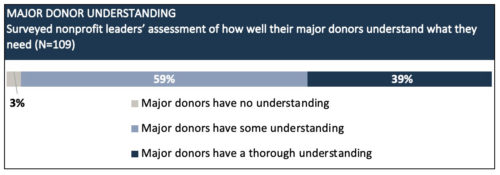As nonprofits, and the people and communities they serve, faced compounding challenges over the past year plus, individual donors have provided crucial support. In fact, increased financial support from individual donors — in addition to foundations and the government — helped nonprofits to fare better through 2020 than nonprofit leaders had expected.1 Further, a recent report from the Urban Institute found that most nonprofits, especially small nonprofits, say that support from individual donors is very important for their work.2
Given the importance of individual donors to nonprofits, in the spring and summer of this year, the Center for Effective Philanthropy (CEP) surveyed and interviewed nonprofit leaders to understand how their experiences working with individual donors have changed since the pandemic began. (For methodological information, please see here.)
Here is what we learned:
The biggest changes that nonprofit leaders have experienced in working with individual donors are:
- Their relationships with individual donors have grown stronger.
- Individual donors have provided them with more unrestricted support.
In this two-part blog series, we examine these changes in-depth. This first post focuses on changes in relationships between nonprofit leaders and individual donors.
Relationships
Nonprofit leaders deeply value their relationships with individual donors, as strong donor-nonprofit relationships lay the groundwork for donors and nonprofits to work together to achieve shared goals.3
Since the pandemic began, more than half of nonprofit leaders have experienced stronger relationships — characterized by more open communication, trust, and respect — with individual donors. About one-quarter have experienced weaker relationships.
Prior CEP research has shown that the two biggest predictors of strong funder-nonprofit relationships are understanding and transparency on behalf of funders.4 When funders understand nonprofit organizations and the contexts in which they operate, they are in a better position to work effectively with nonprofits. And when funders are transparent — meaning that they communicate clearly, openly, and honestly — they give nonprofit leaders the information they need to succeed.
Similarly, nonprofit leaders who have experienced stronger relationships with individual donors during the pandemic speak to greater understanding and transparency from their donors.
In Their Own Words: Interviewed Nonprofit Leaders on How Relationships with Individual Donors Have Become Stronger
“A lot of our donors never attended our in-person programs, but now they’re attending our virtual programs, so we’re able to communicate more with them.”
“We used to have a subscription program where donors could attend in-person shows, but we obviously couldn’t do that this year. Now we have a membership program where donors get significantly less in return for their gifts. We explained to them, ‘We can’t promise you shows, but we can promise you that we’re going to keep investing in artists and connecting them to audiences however we can.’ They understood and responded well, and it changed our relationships from a transaction to a partnership.”
“They listened more, were humbler, had more transparent conversations, and understood that our needs were greater than they were before the pandemic.”
“When donors couldn’t give, they were genuinely transparent about it and conveyed a lot of moral support. That was helpful.”
In addition, when former NBA player and philanthropist Jeremy Lin was recently asked on the Giving Done Right podcast what advice he would give other donors, he emphasized the importance of understanding nonprofits and the communities they work with, saying:
“I started off my philanthropy being like, ‘okay, I’m going to come up with a bunch of good ideas of how I can come in and interject and help.’ Checking myself means putting my ego at the door and realizing that, one, I’m not smarter than these people. Two, there’s people that are doing this work, they’ve literally devoted their lives, their entire career, to this. My job is to come in and basically play a support role and say, ‘what is going on with your community? Do you even need help from me? And if so, how can I help?’ We’re all going through this path of life together. We need each other and we’re going to learn and draw from each other.”5
Conversely, the quarter of nonprofit leaders who say that their relationships with individual donors have become weaker since the pandemic began speak to a lack of understanding on the part of donors. These nonprofit leaders express that their donors do not understand their goals and strategies or what their organizations need. Since the pandemic began, they have had less time to help donors build this kind of understanding.
In Their Own Words: Interviewed Nonprofit Leaders on How Relationships with Individual Donors Have Become Weaker
“We have more major donors than we used to, and they don’t seem to understand exactly what we’re doing. They’re demanding. They want to control what we do, and they want special treatment.”
“We couldn’t hold our gala last year. In some cases, donors gave their usual amount, but in others, they gave less. That feels awkward to me, because I don’t like thinking of our events as so transactional. It shows a disconnect in their understanding of what our organization needs.”
“It’s been hard to stay in touch with donors because we’ve been swamped since the pandemic began. I haven’t had time to call them and let them know what the organization has been doing.”
“Donors haven’t been able to come on site. I used to be able to show them around the site, so they could see what we were up to. But that has been impossible.”
In fact, although more nonprofit leaders say their relationships with individual donors have become stronger since the pandemic began, individual donors still have work to do in developing their understanding of what these organizations need. While many nonprofit leaders feel that major donors — those that give $7,500 or more to their organizations in a given year — have some understanding of their needs, fewer believe they have a thorough understanding.6

Going forward, nonprofit leaders hope that their relationships with individual donors can become even stronger. They say this would take greater understanding of their organizations and more transparency.
In Their Own Words: Interviewed Nonprofit Leaders on What They Most Need From Individual Donors Going Forward
“I would love more individual donors to consider non-transactional relationships with the organizations that they love.”“I want to continue to invest in these relationships with individual donors and build a bond of trust.”“There is an enormous amount of nervousness about how long the graciousness of donors will last. We are nervous that the support is not going to be here a year from now, and we’re trying to plot out a path without knowing, which is really scary. Transparency in those relationships would be incredibly helpful.”
REFLECTION QUESTIONS
To build stronger relationships with nonprofit leaders, we recommend that individual donors reflect on the following questions:
- What does it mean to you to have a relationship with the nonprofit organizations you support?
- Since the pandemic began, what have you done to help build or maintain relationships with the nonprofit organizations you support?
- What resources are you drawing from to develop an understanding of the goals and the issue area(s) of the nonprofit(s) you support?
- Have you asked those leading the nonprofit(s) you support what they most need for their operations and staffing? For their programmatic work? For their own professional development?
Hannah Martin is a manager, research, at CEP. Follow her on Twitter at @hannahqmartin.
- Hannah Martin, Kate Gehling, and Ellie Buteau, “Persevering through Crisis: The State of Nonprofits” (Cambridge, MA: Center for Effective Philanthropy, 2021), https://cep.org/portfolio/persevering-through-crisis-the-state-of-nonprofits/. ↩︎
- Lewis Faulk, Mirae Kim, Teresa Derrick-Mills, Elizabeth Boris, Laura Tomasko, Nora Hakizimana, Tianyu Chen, Minjung Kim, and Layla Nath, “Nonprofit Trends and Impacts 2021” (Washington, DC: Urban Institute, October 2021), https://www.urban.org/sites/default/files/publication/104889/nonprofit-trends-and-impacts-2021_0_0.pdf. ↩︎
- Ellie Buteau, Hannah Martin, and Charis Loh, “Crucial Donors: How Major Individual Givers Can Best Support Nonprofits” (Cambridge, MA: Center for Effective Philanthropy, 2019), https://cep.org/portfolio/crucial-donors-how-major-individual-givers-can-best-support-nonprofits/; “Donors: 5 Things Nonprofits Want You to Know” (Cambridge, MA: Center for Effective Philanthropy, 2018), https://cep.org/portfolio/donors-5-things-nonprofits-want-you-to-know/. ↩︎
- Ellie Buteau, Jennifer Glickman, and Matthew Leiwant, “Relationships Matter: Program Officers, Grantees, and the Keys to Success” (Cambridge, MA: Center for Effective Philanthropy, 2017), http://cep.org/wp-content/uploads/2017/08/Relationships-Matter.pdf. ↩︎
- Jeremy Lin. Interview with Jeremy Lin and Patricia Sun. The Giving Done Right Podcast. Podcast audio. 2021. https://givingdoneright.org/s2-episode4/. ↩︎
- “Persevering through Crisis: The State of Nonprofits” (Cambridge, MA: Center for Effective Philanthropy, 2021), https://cep.org/portfolio/persevering-through-crisis-the-state-of-nonprofits/. ↩︎


